Erotic Sculptures – Nude and Sexual Statues Throughout History
Sex, spirituality, and eroticism are among many of the most popular artistic themes that have been explored by painters and sculptors throughout history. Although ideas about sex, the body, and pleasure have existed for centuries, their acceptance and exposure in the arts sector have only seen recent shifts in the last three centuries. In this article, we will introduce you to specific expressions of sexuality and eroticism in art history, through some of the most famous erotic sculptures to date. Read on for more about these historically steamy, spiritual, and significant artworks!
Contents
- 1 Eroticism and Sexual Expression in Art History
- 2 The Top 10 Most Famous Erotic Sculptures
- 2.1 Pan and a Goat (c. 50 BCE – 50 CE) by Unknown
- 2.2 A Model for the Wedding Night (c. 490 BCE) by Unknown
- 2.3 Mithunas Sculptures of Khajuraho Temples (900 – 1130 CE) by Unknown
- 2.4 The Konark Sun Temple (Est. 1250) by Unknown
- 2.5 Ecstasy of St. Theresa (1647 – 1652) by Gian Lorenzo Bernini
- 2.6 The Temple of Human Passions (c. 1889 – 1896) by Jef Lambeaux
- 2.7 Netsuke Box (18th Century) by Masanao
- 2.8 Jeju Loveland Sculpture Park (Est. 2004) by Hongik University Graduates
- 2.9 Dirty Hippie (2014) by Miley Cyrus
- 2.10 Provocation II by Zhang Yaxi
- 3 Frequently Asked Questions
Eroticism and Sexual Expression in Art History
The discovery of artworks that reveal messages of personal sexual expression or spiritual and superstitious purposes has transformed the way we think about sexuality, the body, and the importance of sexual expression in the arts. Sexual statues of prehistory such as the Venus figurines of the Upper Paleolithic era highlight the value that civilizations of the past placed on the human form and heterosexual female body as a vessel for protection and a symbol for fertility.
Aside from an artwork’s symbolic meaning, other artworks focus on eroticism.
What is eroticism? Eroticism in an art context refers to any artwork that evokes a sensation of sexual desire, sexual arousal, or contemplation on associated themes concerning sex, lust, love, romance, desire, sexual impulses, and practices. The characteristics of erotic artwork are considered to be “fluid” since the meaning of what is considered “erotic” changes depending on the context of the time and societal views.

The human form in sculptural artworks commonly found itself in ancient Greek and Roman art as depictions of local mythologies through preferential Gods and deities that were chiseled out of marble, stone, and ivory. One of the key elements in the exploration of the human form was nudity and as such, was seen as either “too explicit” or “socially acceptable”, depending on the context of the creation.
The duality and transition of nudity in religious art are interesting points to consider when thinking about the origin of eroticism and sexual expression in art. Religious art in ancient antiquity as well as Christian art served to venerate purposes or artistic interpretations of important religious iconographies and narratives. Popular historical artists such as Michelangelo helped normalize the eroticism of the nude human form through sculptures such as David (1501 – 1504). By the mid-16th century, Pope Paul IV declared that the depiction of the penis was to be concealed, which resulted in many 18th-century sculptural artworks adopting the “fig leaf” covering as an alternative.
This anti-sexual war was a form of censorship that dominated Western-European art yet with the transition to Modernism via Impressionism and post-Impressionism, the popularity of nudity in art grew.
This period of anti-sexual war lasted for up to 450 years and resulted in the religious and societal conditioning of shame in sexuality and expressing sexuality and desire in art. Many artists, considered controversial in some cases, challenged the notion of shame in sexuality and eroticism by making these themes the highlight of the artwork itself. It is also important to acknowledge the role of the male gaze in erotic and sexually-charged artworks as an additional layer of criticism that one can approach erotic sculptural analysis and the evocation of desire through the objectification of women and the femme body.
The Top 10 Most Famous Erotic Sculptures
While the definition and understanding of erotic art may shift and always find itself in the face of social controversy, one can still unpack the many historical wonders of erotic art through its oldest art form, sculpture. Below, we will introduce you to some of the most famous erotic sculptures in art history that convey unique histories surrounding the context and social environment in which the works were produced. These sculptures are also crucial to understanding the nature of erotic art and how one might explore sensuality as a recurring theme in one’s practice.
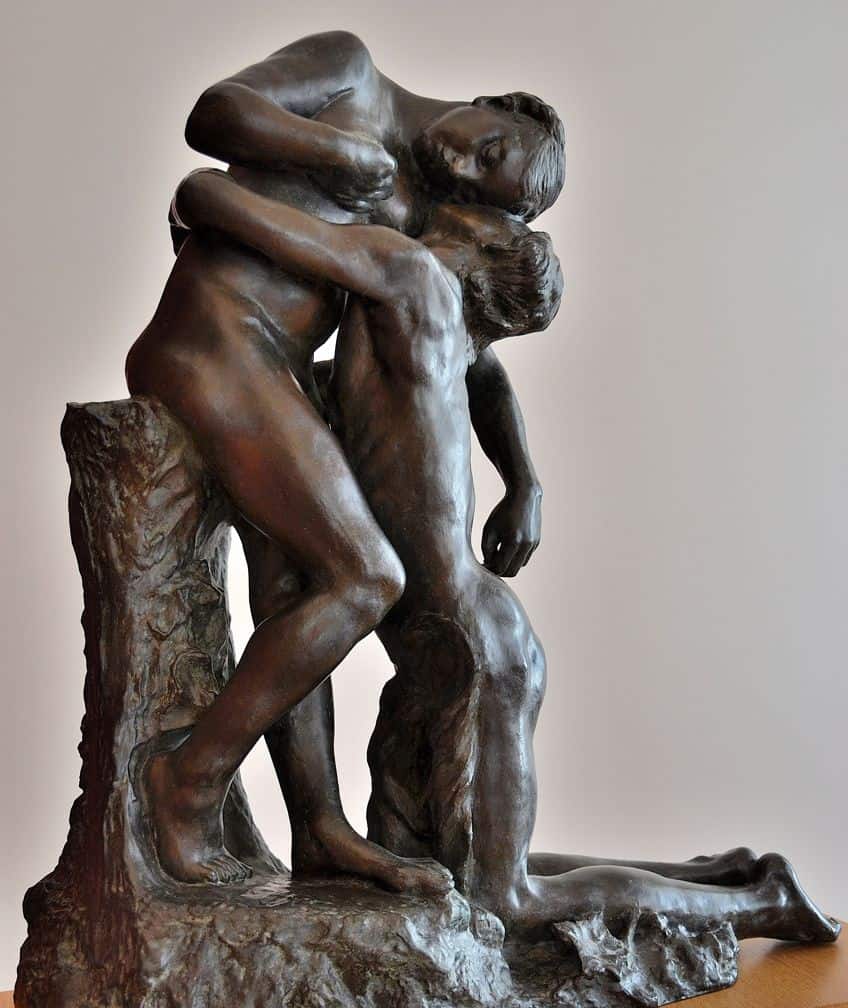
Pan and a Goat (c. 50 BCE – 50 CE) by Unknown
| Artist Name | Unknown |
| Date | c. 50 BCE – 50 CE |
| Medium | Marble |
| Dimensions (cm) | 40.64 x 48.26 |
| Where It Is Housed | The British Museum, London, United Kingdom |
Pan and a Goat is one erotic sculpture that caused a public controversy after its exhibition at the British Museum, which raised the issue of censorship and the display of nude and sexual artworks concerning the audience, which also included children. The sculpture portrays the mythical character Pan having sex with a goat and was best remembered in Greek mythology for his erotic powers. The story of Pan who was inspired by masturbation from Hermes is not particularly favorable since he spread the delight of pleasure solely from a male point of view and was known for seducing shepherds and young women.
The sculpture borders more on bestiality, which is not a theme well-received in art institutional history.
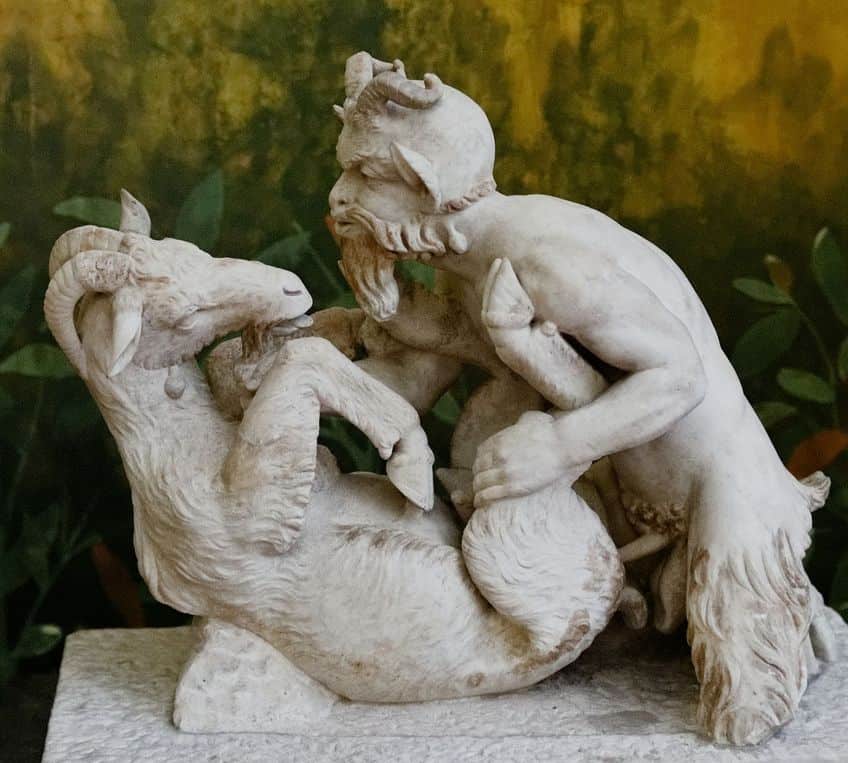
A Model for the Wedding Night (c. 490 BCE) by Unknown
| Artist Name | Unknown |
| Date | c. 490 BCE |
| Medium | Terracotta |
| Dimensions (cm) | Unavailable |
| Where It Is Housed | Altes Museum, Staatliche Museen zu Berlin, Berlin, Germany |
This sensual and openly sexual female nude statue is one of the most famous erotically allusive sculptures from 490 BCE that portrays a woman, believed to be a new bride or a hetaira at a banquet. The sculpture was created by an unknown artist who sculpted the woman with a muscular physique that emphasizes the desirability of her figure and strength in her expression of sexuality, regardless of her societal role.
Many female nude statues were also placed in the graves of young girls who passed away before experiencing companionship or marriage as tokens for the afterlife to remind them of the traditions that would have awaited them.
Mithunas Sculptures of Khajuraho Temples (900 – 1130 CE) by Unknown
| Artist Name | Unknown |
| Date | 900 – 1130 CE |
| Medium | Sandstone |
| Dimensions (cm) | Varied |
| Where It Is Housed | Chhatarpur, Madhya Pradesh, India |
The mithunas sculptures of the Khajuraho temple contain many famous nude statues and sexual statues, which showcase the exploration of sexuality as a spiritual and sacred part of life. The temple is an exhibition of the lifestyle practices of women who existed during the medieval era around the 11th century and contains many sculptures of divine beings, including themes of Shakti and Shiva. The many interesting female nude statues of the temple also provide insight into the early celebration of womanhood as captured through scenes of women adorned in ornate clothing and portrayed among passionate scenes in reliefs with sexual statues.
The temple is also recognized as the Kama Sutra temple, which relays the importance of sexuality and expressions of love to the well-being of all individuals.

In the Medieval age, there was a religious belief that described the importance of possessing erotic sculptures, which were called alankaras, and were considered auspicious. Among the other figures in the temple were sculptures of goblins, mithunas, and erotic nude statues that were included to attract good luck, as stated in the Brihat Samhita text. The artwork at the Khajuraho temple is therefore the ultimate Medieval expression of passion and love, which dominated the East between the 10th and 14th centuries. Buddhist, Hindu, and Jain temples across India also featured erotic sculptures carved at the plinth level, which previously did not attract much attention from viewers.
The Konark Sun Temple (Est. 1250) by Unknown
| Artist Name | Unknown |
| Date | Established 1250 |
| Medium | Chlorite and stone |
| Dimensions (cm) | Varied |
| Where It Is Housed | Konark, India |
The Konark Sun Temple located in Odisha state in India is home to some of the most intriguing erotic sculptures in India. The temple walls feature women and musical performers in different poses on the walls, pillars, and the dancing hall. The temple was constructed in the 13th century by King Narasimhadeva and is currently recognized as a World Heritage Site. The temple’s sculptures give one insight into the daily life of the Orissa people who are most famous for their sculpture of Surya, the sun God. The temple also features sculptures that illustrate same-sex relationships and intimate sexual relationships that promote polygamy and eroticism.
A few of the fallen sculptures from the temple can be viewed at the Konark Archaeological Museum.
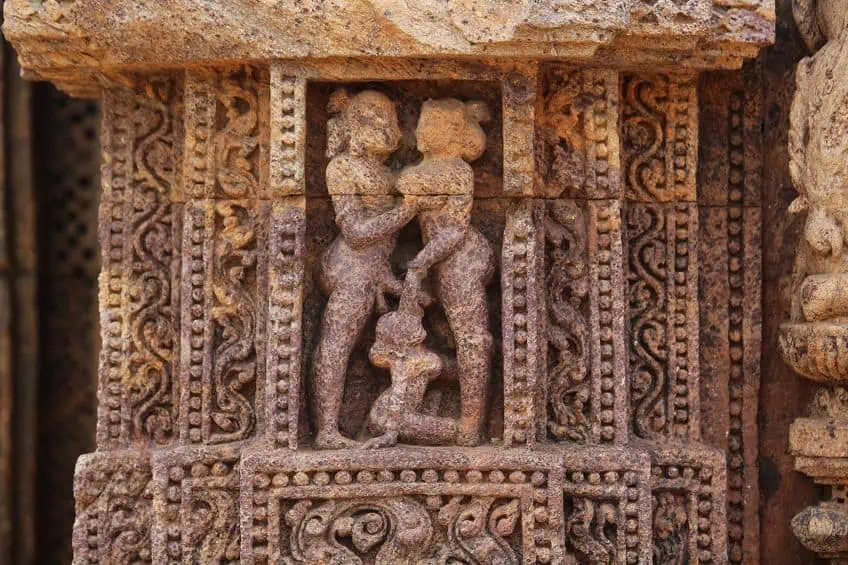
Mithuna scenes in Indian art were considered to be more than just creative expressions, they were viewed as essential parts of life. Sculptures at the Konark temple also portray expressions of detachment from the sexual acts depicted and is admirable from a sculptural lens that early Indian artists were able to creatively capture such a complex spiritual belief. This can be compared to the removal of cerebral sex and an emphasis on Tantric Buddhism. Tantric practices in sex are founded on beliefs that date back to the Rig Vedic era when sex was thought of as more than an intimate act of desire, but as a religion to attain nirvana. According to Tantra beliefs, the desire cannot be overcome by rejecting the desire, instead, it is believed that desire can be overcome through desire itself.
Ecstasy of St. Theresa (1647 – 1652) by Gian Lorenzo Bernini
| Artist Name | Gian Lorenzo Bernini (1598 – 1680) |
| Date | 1647 – 1652 |
| Medium | White marble |
| Dimensions (cm) | 350 (h) |
| Where It Is Housed | The Church of Santa Maria della Vittoria, Rome, Italy |
Sculpted by the master of Baroque sculpture, Gian Lorenzo Bernini, in the 17th century, Ecstasy of St. Theresa is a popular erotic sculpture that is more subtle in its suggestion of sexual pleasure. The sculpture portrays a scene from the life of Teresa when she encounters the divine, defined by an intense experience or reaction to the essence of divinity, and is seen as an expression of religious ecstasy. The sculpture was created in the Counter-Reformation style and was aimed at communicating the spiritual aspects of Catholicism.
It is unclear whether Teresa’s experience of divinity explicitly carries sexual connotations of her physical orgasm or if the work was solely intended for evoking religious ecstasy.

The Temple of Human Passions (c. 1889 – 1896) by Jef Lambeaux
| Artist Name | Jef Lambeaux (also known as Josef Lambeaux) (1852 – 1908) |
| Date | c. 1889 – 1896 |
| Medium | Marble |
| Dimensions (cm) | 1200 x 800 |
| Where It Is Housed | Horta-Lambeaux Pavilion, Brussels, Belgium |
The Temple of Human Passions is one of the best-known examples of erotic sculpture in art history that was sculpted by Jef Lambeaux. Lambeaux was one of the most controversial Belgian artists of his time who left behind many erotic and raunchy sculptures of the late 19th century. He was part of a collective led by Jan van Beers where the artists of the collective known as the van Beers’ clique would hold public activations by dressing up in historical attire and parading around Antwerp. Lambeaux’s erotic sculptures made the Belgian community incredibly uncomfortable since his style was a provocation of romance and lust. Each of his works was sculpted with attention to the relationship and power dynamics expressed in love and especially during sex.
Despite the controversy and shocking brazenness of his artworks, it is not difficult to see that the artist perhaps had a love for the idea of intimate moments and deep emotion expressed in sexual relationships. His carving reflected a romanticization of sex and the different ways that bodies bend, hold down, and interact with each other.
Human Passions is a relief sculpture that was described by L’Art Moderne as “chaotic and vague”, illustrating a “pile of naked, contorted bodies that appeared both pretentious and empty” among the highlights of the critique. One of the key themes in this relief among the concept of sin and happiness was the representation of rape, suicide, and war, which is a chaotic combination of themes that relay the turmoil of war and the struggle for power as per the history of mankind’s relationship to war. The relief fast-tracked to the pitfalls of humanity and was considered ambitious for its combination of subjects in a seemingly disorganized manner. Nudity in art was also commonly associated with sin through a Western point of view and would thus be incorporated in many artworks that tackle the idea of sin, nudity, and desire as “temptations” instead of “godly elements”.
Netsuke Box (18th Century) by Masanao
| Artist Name | Masanao of Kyoto (c. 1700s) |
| Date | c. late 18th century |
| Medium | Ivory, gold, and lacquer |
| Dimensions (cm) | 4.9 (w) |
| Where It Is Housed | The British Museum, London, United Kingdom |
This famous Netsuke Box was created by a Japanese sculptor known as Masanao of Kyoto who specialized in netsuke art and animal carvings. Netsuke art refers to the 17th-century art form involving the creation of miniature sculptures through carving and containing many intricate details. The Netsuke box housed at the British Museum opens up to reveal a couple passionately embracing each other underneath a lacquered blanket. Throughout the 18th and 19th centuries, the art of netsuke carving and sculpture became highly specialized and popular.
The art form also began featuring many miniature erotic sculptures and scenes within these intricate objects, which were considered to be discreet. Masanao of Kyoto earned his reputation as one of the greatest netsuke sculptors of all time.
Jeju Loveland Sculpture Park (Est. 2004) by Hongik University Graduates
| Artist Name | Hongik University graduates |
| Date | Established in 2004 by the South Korean government |
| Medium | Marble and stone sculpture, installation, and interactive sculpture |
| Dimensions (cm) | Varied |
| Location | Jeju Island, South Korea |
Jeju Loveland sculpture park is one of the most famous sites for exploring the relationships between romantic love and eroticism in sculpture. The park was established in 2004 and houses many unique sexual statues and sculptures including stone labia, phallic statues, and educational interactive installations, which help the public unlearn shame around sexual expression and sex education through art. This is one such way in which art has been leveraged to not only relay artistic skill but also educate and normalize sex and society’s relationship with historically “taboo” subjects. In the late 20th century, Jeju Island was recognized as a popular destination for many newlyweds, which was brought on as a result of an increase in arranged marriages. Since then, the South Korean island has been established as one of the primary sites for the promotion of sex education.
Many of the sculptures at the park were created by graduate artists from Hongik University in 2002.
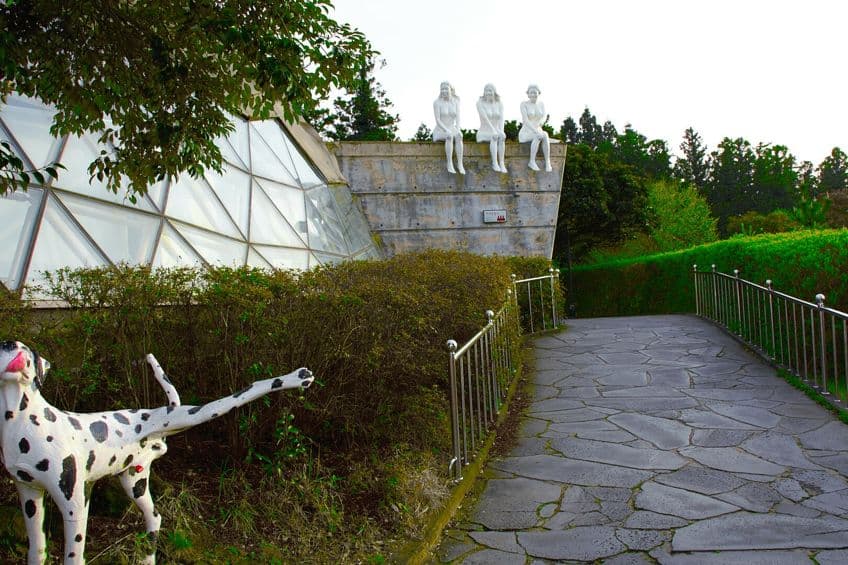
Dirty Hippie (2014) by Miley Cyrus
| Artist Name | Miley Ray Cyrus (1992 – Present) |
| Date | 2014 |
| Medium | Mixed media |
| Dimensions (cm) | Varied |
| Where It Is Housed | Unavailable |
Dirty Hippie is a series of erotically-charged artworks created by the pop musician and sculptor, Miley Cyrus, and explores sexuality and eroticism through unique combinations of unconventional yet sexually suggestive materials. Cyrus’ unique sculptures reflect the artist’s inner world and public persona as defined by terms such as “sex-loving party girl”, which promotes a sex-positive approach to sculpture through various multi-media assemblages. Some of the materials found in Cyrus’ colorful and provocative sculptures include marijuana joints, vibrators, party favors, and pineapples, which reflect her experience of living life to the fullest.
The Dirty Hippie series formed part of a collaborative project, which Cyrus worked on with Moschino designer Jeremy Scott. Cyrus’ efforts were critiqued as sculptures that looked like children’s toys and plastic beads that reflected the aesthetic of the 90s EDM culture.
Provocation II by Zhang Yaxi
| Artist Name | Zhang Yaxi |
| Date | Unavailable |
| Medium | Bronze resin or bronze |
| Dimensions (cm) | 23 x 21 x 25 |
| Where It Is Housed | Artist’s collection |
Provocation II is an expressive bronze erotic sculpture that explores the theme of feminine desire through nudity and various nude female statues in sexually suggestive positions. The Chinese artist Zhang Yaxi is currently one of the most famous Contemporary female sculptors whose provocation of the emotional femme body is carefully executed through her figural sculptures. Her works also embody the concept of desire through the bodily gestures of the figures, which suggest an exhaustive desire accompanied by self-pleasure and an openness to explore the body while admiring its positions as a reaction to desire.
While there are many erotic artworks created by male artists that starkly border on the line of the objectification of women, it is increasingly important in Contemporary society that more artists explore sexuality and eroticism in sculpture through a more diverse lens that offers insight into more than just the highly problematic male gaze.
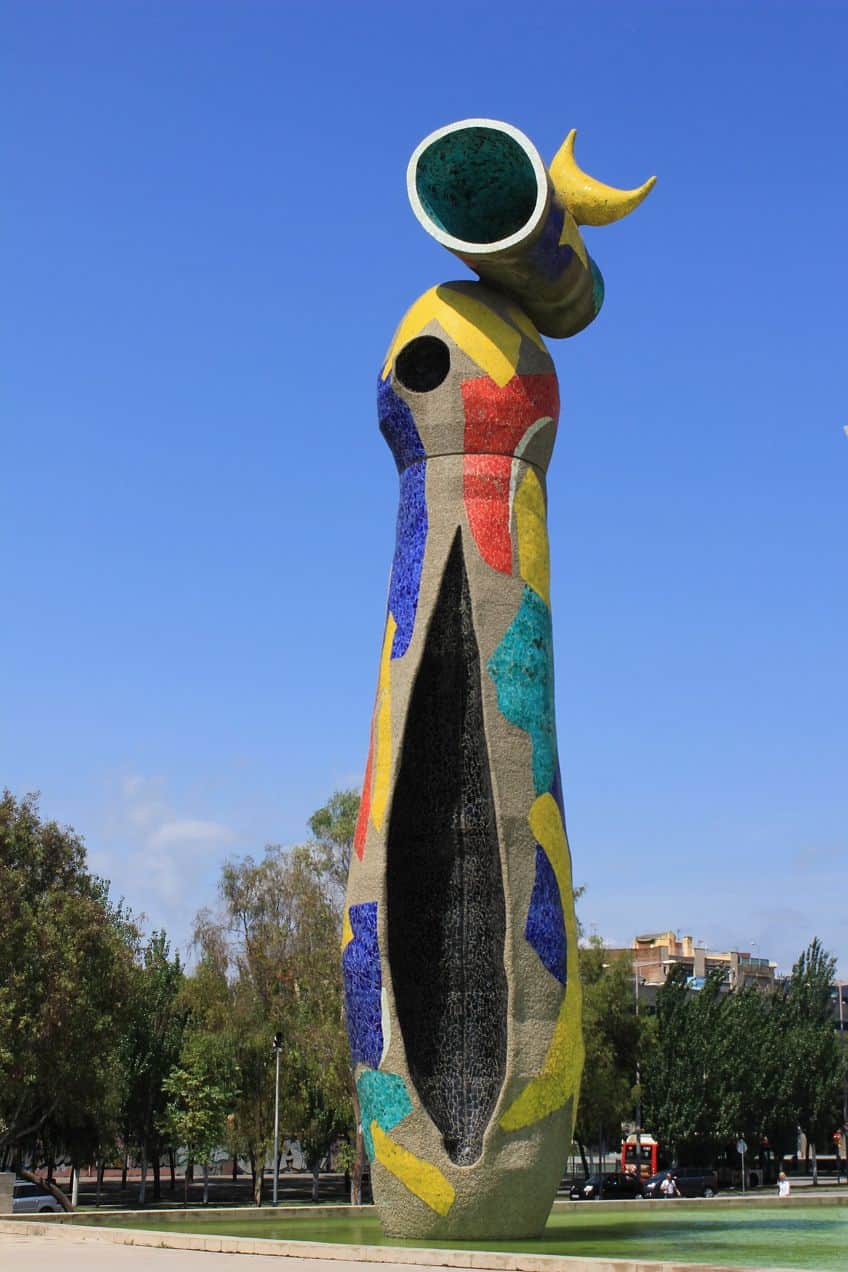
Asking important questions such as “who makes erotic art?” and “what makes erotic art problematic to society? “ are excellent first steps in navigating the complexities of eroticism in art history. Other important erotic sculptures to study include works such as Dona i Ocell (1983) by Joan Miro, the mysterious Marree Man (c. 1998) earth sculpture, Pi-Chacán (2001) by Fernando de la Jara, and Dirty Corner (2011) by Anish Kapoor that move beyond the nuanced theme of eroticism.
The medium of sculpture has been effective in showcasing the different views on sex and eroticism that help normalize and inform artists on how one can approach and analyze erotic artworks. The development of erotic themes in art across the centuries has seen many shifts, yet the emphasis on an appreciation for the human body and the themes of intimacy, sexuality, and human expression has been consistent. We hope that you have enjoyed exploring eroticism through sculpture with us!
Frequently Asked Questions
What Is Eroticism?
Eroticism is defined as an element or stimulus that causes the sensation of sexual desire evoked by a sensual stimulus, which can be visual, auditory, or inspired by text-based works. Eroticism is closely associated with sexual arousal and features in different art forms, including sculpture, photography, film, painting, literature, and music.
What Is Erotic Sculpture?
Erotic sculpture refers to any sculptural artwork that evokes in the viewer a sexual desire, stimulated by the form, subject, shape, and composition of the sculpture. Erotic sculptures are affiliated with the Greek term eros, from which the word erotica was formed. In art history, erotic sculptures tackle themes of sensuality, the female nude form, the male gaze, sexuality, sexual expression, desire, lust, sin, purity, tantra, and spiritual awakening.
Which Temples in India Feature Erotic Sculptures?
Many temples in India feature erotic sculptures and statues on their walls and columns. These temples include the Jain temples, the Lingaraj temple, the Virupaksha temple, the Khajuraho temples, the Sun temple, the Sathyamurthi Perumal Temple, and many others.
Why Are Erotic Sculptures Controversial?
Erotic sculptures are considered to be controversial since the main issue with the art form is the issue of censorship, and how much nudity is too much nudity in art when it comes to exhibiting for the public. The issue of nudity and censorship of artworks was founded on the social conflict of allowing minors and children, who also experience art, to view erotic artworks. Erotic sculptures also become controversial when the subjects and visual translation of erotic concepts defy societal norms, or appear pornographic.
Jordan Anthony is a Cape Town-based film photographer, curator, and arts writer. She holds a Bachelor of Art in Fine Arts from the University of the Witwatersrand, Johannesburg, where she explored themes like healing, identity, dreams, and intuitive creation in her Contemporary art practice. Jordan has collaborated with various local art institutions, including the KZNSA Gallery in Durban, the Turbine Art Fair, and the Wits Art Museum. Her photography focuses on abstract color manipulations, portraiture, candid shots, and urban landscapes. She’s intrigued by philosophy, memory, and esotericism, drawing inspiration from Surrealism, Fluxus, and ancient civilizations, as well as childhood influences and found objects. Jordan is working for artfilemagazine since 2022 and writes blog posts about art history and photography.
Learn more about Jordan Anthony and about us.
Cite this Article
Jordan, Anthony, “Erotic Sculptures – Nude and Sexual Statues Throughout History.” artfilemagazine – Your Online Art Source. April 24, 2023. URL: https://artfilemagazine.com/erotic-sculptures/
Anthony, J. (2023, 24 April). Erotic Sculptures – Nude and Sexual Statues Throughout History. artfilemagazine – Your Online Art Source. https://artfilemagazine.com/erotic-sculptures/
Anthony, Jordan. “Erotic Sculptures – Nude and Sexual Statues Throughout History.” artfilemagazine – Your Online Art Source, April 24, 2023. https://artfilemagazine.com/erotic-sculptures/.


